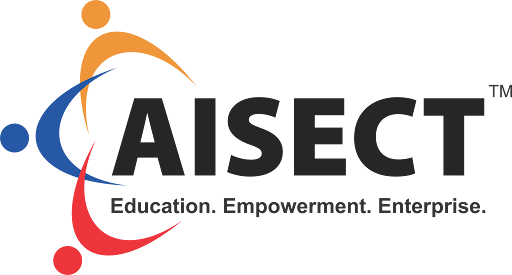|
Enterprise Showcase
Dialogue with Dr. Siddharth Chaturvedi, Executive Vice President, AISECT Group
|
|

1 AISECT has pioneered skill development and livelihood generation, especially in rural and semi-urban India. Please walk us through AISECT's evolution—from its early vision to the impact it has created today. How has the organization adapted to changing workforce dynamics, technological disruptions, and policy shifts over the years?
|
AISECT began with a pioneering vision to bridge the skill gaps in rural and semi-urban India, creating opportunities for youth through accessible vocational training. What started as focused training in computer education and electronics has evolved into a comprehensive ecosystem addressing multiple sectors, including retail, agriculture, healthcare, IT, finance, education, and renewable energy.
As the demand for skilled professionals grew, AISECT adapted to changing workforce dynamics by integrating practical training with academic learning. We have developed deep partnerships with industry leaders to ensure our training programs directly address workforce needs. These collaborations have evolved from basic curriculum inputs to comprehensive engagement, including co-created learning pathways, industry-certified credentials, and direct employment pipelines. This active inclusion of industry partners in every aspect of our training ecosystem has ensured that students acquire skills with immediate market relevance.
In response to technological disruptions, AISECT has embraced AI-driven learning and digital platforms while recognizing the rapidly changing nature of work. We have progressively shifted toward equipping learners with future-ready competencies beyond technical skills, prioritizing digital literacy, adaptability, entrepreneurial thinking, and problem-solving capabilities. Our initiatives under programs like Microsoft RISE and the Passport to Earning (P2E) program with UNICEF specifically target emerging opportunities in the digital economy, financial technology, and sustainable development sectors.
Understanding that language barriers often prevent talented individuals from accessing quality training, AISECT has developed a comprehensive EdTech platform, AISECT Learn, delivering courses in multiple regional languages. This initiative has democratized access to quality educational content, allowing learners to develop skills in their native languages. The platform combines AI-driven learning pathways with culturally relevant content, making technical education truly accessible across India's diverse linguistic landscape.
As policy frameworks like Skill India reshape the skilling ecosystem, AISECT continuously updates its curriculum, collaborates with government initiatives, and expands partnerships to align with national goals. Our commitment to inclusive skill development through technology integration, industry collaboration, and focus on future skills has positioned us as an enduring leader in India's journey toward a skilled and empowered workforce.
|
2
Despite significant efforts in the livelihoods space, India continues to face persistent challenges such as job informality, underemployment, and lack of access to market-relevant skills. What are the biggest structural barriers preventing the sector from scaling effectively? Have any innovative approaches—whether in financing, public-private collaboration, or community-driven solutions—shown promise in overcoming these barriers?
|
Millions of Indians struggle with employment stability due to job informality, underemployment, and skill mismatches with industry demands. The disconnect between training programs and actual workplace requirements leaves job seekers underprepared, while financial barriers and limited accessibility, particularly in rural areas, further complicate large-scale skill development initiatives.
AISECT tackles these challenges through a multi-faceted approach that begins at the grassroots level. We have established direct connections with local employers through our network of skill centres, conducting regular needs assessments and skill gap analyses in each region. This localized understanding allows us to design training programs that precisely match the requirements of businesses in each community, ensuring that graduates possess market-relevant skills that lead to immediate employment opportunities.
Our experience reveals that residential training programs produce significantly better outcomes for skill development. These immersive learning environments eliminate distractions, create peer learning communities, and allow for extended practice sessions. The residential model has proven especially effective for youth from disadvantaged backgrounds, with significant improvement in the placement rates in comparison to the non-residential programs.
To address the evolving nature of work, AISECT has adopted micro-credentials across our curriculum. These focused, short-duration certifications in specific competencies allow learners to build skill portfolios that precisely match employer requirements. Our partnership with NASSCOM provides validated credentials in emerging technologies like IoT and blockchain, ensuring our graduates remain competitive in rapidly changing industries.
Recognizing the challenge of underemployment, AISECT emphasizes multi-skilling in our training approach. Beyond technical expertise, our programs integrate entrepreneurship training, financial literacy, and digital marketing skills that enable graduates to generate sustainable income streams. This approach has been particularly successful in our agriculture programs, where participants learn crop production alongside food processing and direct-to-consumer marketing techniques, significantly increasing their earning potential.
Beyond our work with NSDC, AISECT has developed strategic partnerships with several major organizations to expand our skill development reach and impact. Our recent partnership with Arcelor Mittal & Nippon Steel CSR demonstrates our commitment to sector-specific skill enhancement. Through this initiative, we have successfully trained 200 candidates for specialized roles in the Telecom and IT/ITeS sectors, significantly improving their employability prospects and addressing industry-specific talent needs.
The STEM for Girls program, implemented in collaboration with IBM and Quest Alliance, has been transformative for young women in Andhra Pradesh and Telangana. This initiative has empowered 13,887 girls with crucial STEM skills, helping to bridge the gender gap in technical education and preparing the next generation of female leaders in technology fields.
Our partnership with Samsung Dost represents another important dimension of our work, focusing on retail skills development in southern India. This collaboration is driving specialized training across Andhra Pradesh, Telangana, and Karnataka, empowering 284 candidates to excel as in-store promoters and demonstrators. This initiative particularly benefits youth and women seeking opportunities in the growing retail technology sector.
|
3
As one of India’s largest skilling and vocational training networks, AISECT has worked extensively with both public and private sector partners. Based on your experience, what policy reforms or structural changes are needed to strengthen India’s livelihoods ecosystem? Are there specific regulatory bottlenecks or funding gaps that need urgent attention?
|
Strengthening India's Livelihoods Ecosystem: Essential Reforms
To strengthen India's livelihood ecosystem, several policy reforms and structural changes are needed. While the National Education Policy (NEP) has established excellent enabling policies for integrating vocational training into the formal education system, their effective implementation is the key to achieving the desired results. The NEP provides a framework for mainstreaming vocational education both at school and higher education institution (HEI) levels, which could significantly address the current mismatch between traditional education and job market requirements.
The comprehensive curriculum frameworks, including the National Credit Framework (NCrF), National Skills Qualification Framework (NSQF), and National Higher Education Qualification Framework (NHEQF), collectively pave the right way forward at the policy level. When properly implemented, these frameworks have the potential to make the entire vocational and formal education ecosystem more industry-integrated, creating a more effective pipeline for workforce readiness.
Funding for skill development initiatives could be significantly enhanced by encouraging CSR budget pooling at the state level across India. This consolidated approach would allow State Skill Missions to strategically redeploy these resources into high-impact skilling programs that align with regional economic priorities and employment opportunities.
The skill industry requires access to impact financing at a much larger scale, particularly patient capital that can wait for long-term structural changes to be implemented. Traditional funding models often expect quick returns, which do not align with the time needed for meaningful skill development outcomes. Additionally, further activation of the Social Stock Exchange would provide critical access to grant capital for organizations working in skill development and livelihood creation.
To improve training effectiveness, promoting residential training programs and better utilizing existing district-level infrastructure such as Jan Shikshan Sansthan (JSS), Pradhan Mantri Kaushal Kendra (PMKK), and Mega Skill Centres on a hub-and-spoke model would enhance reach and quality. This approach would help overcome accessibility barriers, particularly in rural and underserved areas.
While the Union Budget 2025-26 demonstrates a strong focus on educational initiatives and innovation, these funds must be strategically deployed to implement these necessary reforms and bridge existing gaps in the skill development landscape. By addressing these structural issues, India can create a more sustainable, scalable ecosystem that effectively aligns industry requirements with training programs and ensures inclusive, impactful skilling initiatives.
|
4
Job retention remains a major challenge even after successful mobilization, training, and placement.
a) What are the primary reasons for high attrition rates among newly skilled workers?
b) What strategies have proven effective in ensuring long-term workforce engagement and career progression?
|
AISECT recognizes that job retention is a critical challenge, even after successful mobilization, training, and placement. Several key factors contribute to high attrition rates among newly skilled workers:
Primary Reasons for High Attrition Rates
- Mismatch Between Job Expectations & Reality – Many candidates struggle with workplace culture, job responsibilities, or salary expectations.
- Lack of Career Progression – Limited growth opportunities lead to disengagement and job-switching.
- Migration & Family Commitments – Candidates from rural areas often prefer jobs closer to home, affecting retention in urban-based placements.
- Workplace Adaptability & Soft Skills Gaps – Inadequate communication, teamwork, and adaptability skills hinder long-term success.
- Financial Constraints & Immediate Needs – Some candidates leave jobs for quick income sources rather than long-term careers.
- Poor Employer-Employee Engagement – Lack of mentorship, workplace integration, and job satisfaction leads to early exits.
AISECT's Strategies for Long-Term Workforce Engagement & Career Growth
- Localized & Demand-Driven Skilling – AISECT aligns skill development programs with industry needs in candidates' home regions, reducing migration challenges.
- Industry Partnerships & Apprenticeships – Strengthening employer linkages ensures better job matching and workplace readiness.
- Post-Placement Support & Career Guidance – Continuous mentoring, alumni networks, and career counselling encourage retention.
- Soft Skills & Workplace Readiness Training – AISECT integrates communication, digital literacy, and professional skills into training curricula.
- Entrepreneurship Development – Encouraging self-employment through financial literacy, MSME support, and start-up incubation.
- Technology-Driven Learning & Upskilling – AISECT promotes lifelong learning through AISECT Learn, Microsoft RISE, and digital platforms to enable career growth.
- Skill-Based Certifications & Micro-Credentials – Providing globally recognized certifications ensures long-term employability and upskilling opportunities.
- Recognition of Prior Learning (RPL) & Reskilling – Helping workers transition to new roles with relevant certifications and continuous training.
Future Plans for Workforce Retention & Growth
- Expansion of AISECT's Skill Academies – Strengthening sector-specific skill training with job-market-aligned courses.
- Enhanced Industry Collaborations – Increasing MoUs with leading corporates to ensure better job security and career advancement.
- AI-Driven Career Tracking & Support Systems – Implementing AI-based tools to track placements, engagement, and job retention rates.
- Women-Centric & Rural Employment Models – Special initiatives to empower women and rural youth with flexible work opportunities
|
5
The informal sector accounts for a large portion of India’s workforce, yet access to formal skilling, credit, and social security remains limited. What role do self-employment models, digital skilling platforms, and government schemes like MUDRA play in this transformation?
|
India's informal sector constitutes a significant portion of the workforce, contributing nearly 45-50% of the nation's GDP. However, limited access to formal skilling, credit, and social security continues to hinder the growth and stability of informal workers. Addressing these challenges is crucial for India's journey toward sustainable economic growth by 2047.
Self-employment models offer a vital pathway for informal workers, enabling them to generate income flexibly while leveraging their existing skills. These models also create opportunities for gradual formalization by encouraging business registration and financial inclusion. To maximize this potential, better utilization of existing incubation centres across India presents a significant opportunity to provide entrepreneurial support at scale. These centres can be transformed into accessible hubs offering essential services like business mentorship, market linkages, technological assistance, and shared infrastructure, especially in smaller towns and rural areas where traditional business support is often lacking.
The foundation for entrepreneurial growth must begin early, making the introduction of entrepreneurship curriculum at the school level a crucial intervention. By integrating entrepreneurial education into formal schooling, we can cultivate business acumen, innovative mindsets, and problem-solving skills among young learners. This approach normalizes entrepreneurship as a viable career path and prepares future generations with the skills needed to thrive in self-employment, ultimately creating a pipeline of informed entrepreneurs who can contribute to formalizing various sectors of the economy.
Digital skilling platforms have emerged as a transformative force, bridging the skill gap by providing accessible training. These platforms cater to workers in remote areas and those with irregular work schedules through flexible, module-based learning, equipping them with essential digital and vocational skills to adapt to evolving job roles.
Government initiatives like the MUDRA scheme play a crucial role in addressing credit barriers for informal sector workers. Since its launch in 2015, the Pradhan Mantri Mudra Yojana (PMMY) has disbursed ₹31.85 trillion of the ₹32.61 trillion allocated, highlighting the demand for credit among micro and small businesses. Similarly, the introduction of the e-Shram portal in 2021 marked a significant step toward social security for informal workers, integrating various welfare schemes and enrolling over 290 million workers.
However, the mere existence of social security schemes is insufficient without widespread awareness. Strategic awareness drives on social security benefits for informally employed workers are essential to bridge this information gap. Many workers remain unaware of available benefits like insurance coverage, pension schemes, and healthcare provisions. Targeted awareness campaigns through community centres, mobile outreach, and digital platforms can significantly increase enrollment and utilization of these critical safety nets, enhancing economic resilience among informal workers.
While these interventions have made notable progress, challenges remain in ensuring comprehensive social protection and economic stability for informal workers. Strengthening policy frameworks, expanding digital literacy, and enhancing financial inclusion will be essential in driving meaningful transformation in India's informal sector.
|
6
Gender disparities continue to limit women’s participation in vocational training and employment. What specific challenges do women face in accessing skilling programs and sustainable livelihoods? Can you share a successful gender-responsive intervention that led to better economic outcomes for women?
|
Ans: Gender disparities remain a significant challenge, restricting women’s participation in vocational training and employment and limiting their economic independence. At AISECT, we recognize the barriers women face in accessing skill development programs and securing sustainable livelihoods.
Women's Empowerment Through AISECT's Gender-Focused Initiatives
AISECT addresses gender disparities through targeted interventions designed specifically for women's advancement in the digital economy. Our portfolio includes:
Microsoft RISE Program
Empowering rural women across 8 states with foundational digital literacy, communication skills, AI knowledge, and entrepreneurship training. This flagship initiative has reached over 300,000 beneficiaries, creating pathways to formal employment opportunities.
Azure Cloud Computing Initiative
Providing specialized IT/ITeS sector training for 800 participants in Uttar Pradesh and Madhya Pradesh, focusing on advanced cloud computing skills that open doors to technology careers.
Target regions: Madhya Pradesh, Uttar Pradesh
Skills for HER (NASSCOM-Accenture Partnership)
Addressing the tech gender gap through advanced IT training in Full Stack Java Development and Cybersecurity for 432 women across southern states, fostering financial independence.
Implementation areas: Telangana, Andhra Pradesh, Tamil Nadu
UNICEF E-Placement Initiative
Nationwide program delivering comprehensive digital and financial literacy combined with job placement services, helping 3,000 young women bridge the gap between skills and employment opportunities.
Coverage: Multi-state
Giridih Women's Digital Empowerment Pilot
Community-focused intervention in Jharkhand reaching 5,000 women with essential digital skills training, job placement assistance, and self-employment support, creating a scalable model for women's economic empowerment.
Focus location: Giridih, Jharkhand
Women's Entrepreneurship Development
Comprehensive support ecosystem for women entrepreneurs featuring financial literacy education, digital business tools training, and micro-financing access to foster sustainable women-led enterprises.
Strategic Future Direction
AISECT is committed to expanding our gender-inclusive approach by
- Scaling digital and financial literacy programs in underserved communities
- Creating pathways for women into emerging technology fields, including AI, programming, and green economy sectors
Through these strategic interventions, we are working to create a future where women have equitable access to skills development, sustainable employment, and economic independence.
|
|
|
Dr. Siddharth Chaturvedi, Executive Vice President, AISECT Group
Dr. Siddharth Chaturvedi is the Executive Vice President of AISECT Group, India's leading social enterprise in skill development, higher education, and financial inclusion. He is also the Chancellor of Scope Global Skills University, Bhopal, and serves on key industry committees, including CII and TiE. With a background in engineering and management, he has played a pivotal role in AISECT’s expansion, growing its network to 31,000+ centers and impacting millions through education and employment initiatives. His leadership continues to drive AISECT’s mission of empowering rural and semi-urban India.
About AISECT
AISECT is one of India’s leading social enterprises focused on skill development, vocational training, and digital empowerment in rural and semi-urban areas. With a vast network of training centers and university collaborations, AISECT has impacted millions through its industry-aligned programs in IT, banking, entrepreneurship, and emerging technologies. Partnering with government and private sector initiatives, AISECT bridges the education-employability gap, ensuring workforce readiness. Through innovative models like blended learning and financial inclusion programs, AISECT continues to drive sustainable livelihoods and economic growth across India.
|
|
About Impact Investors Council:
Impact Investors Council, India (IIC) is a member-based national industry body formed with an
objective to build and strengthen the impact investing eco-system in India. To know more about our work visit https://iiic.in or reach out to secretariat@iiic.in
|
Disclaimer: Data and Information in this newsletter is made available in good faith with the exclusive intention of helping market and ecosystem players, policymakers and the public build a greater
understanding of the Indian impact investing market. The data is collated from sources believed to be reliable and accurate at the time of publication. Readers are urged to exercise independent judgment and diligence in the
usage of this information for any investment decisions
Some of the information provided in this newsletter is supplied by third parties. It is important that all users understand that third party information is not an endorsement of any nature and has been put together with the
sole purpose of benefiting stakeholders.
|
| Unsubscribe |
|
|
|


